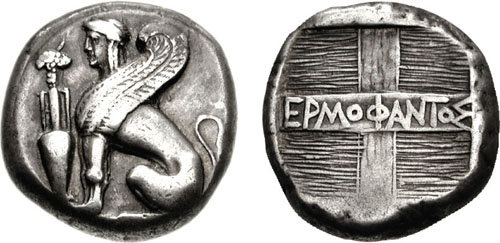Historical Coins – Touchstones to the PastThere is nothing more fascinating than collecting coins, all history is summed up in them...they are the story of humanity. W.H. Valentine (1856-1927) We all appreciate beauty around us and want to connect in some tangible way with our past. We also thrill to the hunt, searching out the elusive quarry, catching it, and then showing our catch to others. Collecting satisfies these basic passions, while it enriches both our lives and those of our family, friends, and colleagues. Its roots begin very early when, as young children, we save brightly colored fall leaves, or fill our pockets with unusually shaped and interesting rocks, tangible reminders of our own experience and enjoyment. As we grow older, what interests us takes new forms and what we may collect follows along. It provides stress relief from our daily work and recharges our energies. It affords us an opportunity to stimulate our intellect and study new ideas, people, and places. It allows us to converse with and share in the camaraderie of other great and small collectors, both of the past, as well as the present. Most of all, it is a fun and affordable hobby. What is an historical coin? Certainly the EID MAR denarius pictured here, arguably the most famous and widely recognized ancient coin, can properly be called historical. Minted by one of Caesar’s assassins, Brutus this coin was issued to pay his soldiers just prior to the battle at Philippi. The coin’s design, with its head of Brutus, and the pileus, or cap of Liberty between two daggers, not only commemorates Caesar’s recent assassination and the restoration of freedom, but also recalls Brutus’ ancestor (also named Brutus), who expelled the last king from Rome in 509 BC, thereby establishing the Roman Republic. Ancient coins can be considered historical for other reasons as well. The early electrum coins of western Asia Minor, perhaps the first ever struck, represent the dawning moment in the development of coinage. The classical Athenian tetradrachm with its archaic-style portrait of Athena and owl, by virtue of its wide acceptance, demonstrated the far-reaching power and influence of that tiny city-state, until the tetradrachms of Alexander III “the Great” replaced it. The Hellenistic kingdoms were the first to include the realistic portrait of the living ruler in the design of their coinage. Now, it was possible for the royal subjects to view the actual features of their ruler, warts and all. Many ancient and medieval coins are dated, and one can collect the issues of certain significant dates, such as the millennium of Rome’s founding, the conquest of Delhi by Nadir Shah, or the sailing of the Spanish Armada. Greco-Roman mythology, the foundation of Western art and culture, is also prevalent. Whether as a wry pun on the city’s name on classical Greek coins, such as Herakles on the issues of every Greek town called Herakleia, the hope of divine guidance or protection, such as Zeus Nikephoros or Athena Alkidemos on later Hellenistic issues, or some local mythological point of pride, such as the tale of Hero and Leander on the provincial coins of Sestus in the Hellespont, these images continued to be used well into the present. Ancient historical coins open up a world of collecting possibilities to the individual of every budget. They are often in their own right miniature works of art, as well as touchstones to great individuals and civilizations of the past. 
On Coins and Medals, &c.Of the many hobbies that appeal to a refined taste, to the mind nurtured in the love of ancient and modern times, and to the cultured intellect which delights in unraveling the mysteries and oft tangled skeins of mythology and history, no pursuit can claim priority of interest or fascination over the study and collection of coins and medals. These small but intensely interesting and truly veracious monuments of both ancient and medieval times place before the collector at a glance something vividly characteristic of the period in which they were issued - it may be the finely chiseled features of some god or goddess of mythology, some long forgotten customs of a now extinct people, or the authentic portrait of some ancient conqueror of half the world. All these things, therefore, appeal to the well educated and enquiring connoisseur, and if he be (as who is not these days?) a lover of art as well, then he/she can hardly fail to be attracted by the well-nigh irresistible charm which attaches to coins and medals. From The Connoisseur. An Illustrated Magazine for Collectors. Volume III (1902). |